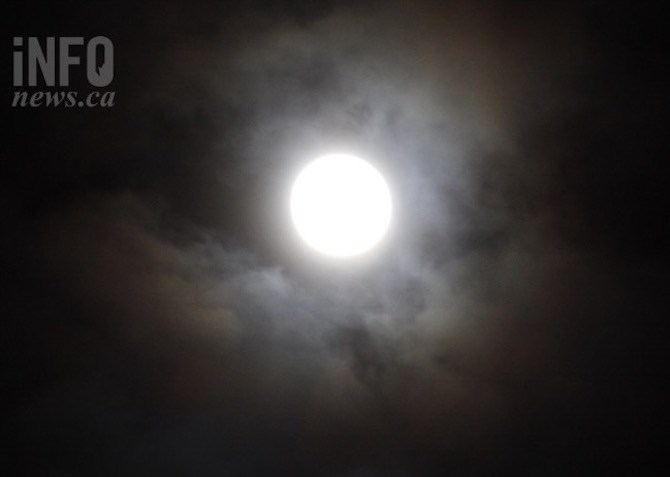
Viewers of this month's controversial supermoon may have to wait for a break in the clouds for viewing opportunities this weekend.
(STEVE ARSTAD / iNFOnews.ca)
March 27, 2021 - 9:00 PM
This March 28 get outside and take in the full moon — it will look about 16 per cent brighter than usual.
It also heralds a lot of change, if you believe sky watchers. To some it's known as the “Full Worm Moon.” The name relates to the fact that it’s spring and with thawing ground, earthworms appear once again.
It’s also known as the "Full Crow Moon," for the time when cawing crows signify the end of winter, or the "Full Crust Moon” because snow crusts over with freezing nighttime temperatures, according to farmersalmanac.com
What is unique about this month's full moon is it could arguably be called a supermoon but that term is open to interpretation.
While there is no official definition for the term "supermoon," it is generally labelled such when the full or new moon occurs during its closest approach to Earth, during the moon’s elliptical orbit around the planet.
This point is called the perigee.
According to the website, timeanddate.com, there are only two super full moons in 2021 – in April and May.
The website defines a supermoon as a “new or full moon that occurs when the centre of the Moon is less than 360,000 kilometres from the centre of the Earth.
If that’s the case, then this March’s supermoon misses that definition by a mere 2,170 kilometres, at 362,170 km from Earth.
April's full moon is 357,615 kilometres away, and May's is 357,462 kilometres from Earth.
Other sources define a supermoon differently. For example, astrologer Richard Nolle, who coined the term "supermoon," defined it as a new or full moon that occurs when the moon is at or near (within 90 per cent of) its closest (perigee) approach to Earth.
According to earthsky.org depending on whether you choose the year’s closest perigee or the perigee for a given monthly orbit, Noelle’s definition of a supermoon can be narrowed or broadened – suffice to say the explanation is complicated.
At any rate, the March 28 full moon will look about 16 per cent brighter than an average full moon.
It officially occurs at 11:48 a.m., Sunday morning, but is best viewed Saturday or Sunday evening - that is, if we can see it.
Environment Canada is calling for cloudy skies on Saturday night and clouds with a possibility of showers for Sunday night in Kamloops and the Okanagan.
To contact a reporter for this story, email Steve Arstad or call 250-488-3065 or email the editor. You can also submit photos, videos or news tips to tips@infonews.ca and be entered to win a monthly prize draw.
We welcome your comments and opinions on our stories but play nice. We won't censor or delete comments unless they contain off-topic statements or links, unnecessary vulgarity, false facts, spam or obviously fake profiles. If you have any concerns about what you see in comments, email the editor in the link above.
News from © iNFOnews, 2021